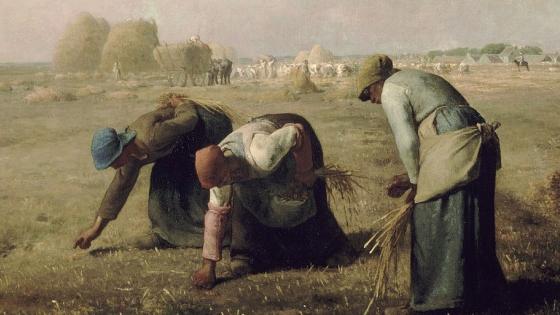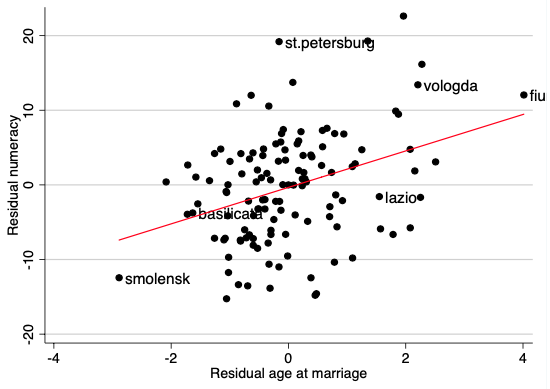What are the crucial ingredients for the success or failure of economies in the long term? Is female autonomy one of the critical factors? Looking at recent growth successes and failures, some of the positive stories were characterised by relatively high female autonomy. For example, Botswana had some of the highest GDP growth rates in the last decades worldwide. It had not only favourable institutions, but also high gender equality (Robinson 2009, and see Carmichael and Dilli 2014 for data on gender equality). Similarly, China and South Korea moved from extreme gender inequality in the early 20th century – seen in practices such as foot binding of Chinese women – to relatively high gender equality during the 1960s and 1970s, before the most dramatic economic growth process in the world economy could set in.
A number of development economists have found higher gender inequality to be associated with slower development. Amartya Sen (1990) estimated a large number of ‘missing women’, which resulted in skewed sex ratios, and argued that this has been one of history’s crucial development hurdles. Stephan Klasen, with various co-authors, used macroeconomic regressions to show that gender inequality has usually been associated with lower GDP growth in developing countries during the last few decades (Klasen and Lamanna 2009, Gruen and Klasen 2008). This resulted in development policies targeted specifically at women. In 2005, for example, UN Secretary General Kofi Annan stated that gender equality is a prerequisite for eliminating poverty, reducing infant mortality, and reaching universal education (UN 2005). In recent periods, however, a number of doubts have been made public by development economists. Esther Duflo (2012) suggested that there is no automatic effect of gender equality on poverty reduction, citing a number of studies. The causal direction from poverty to gender inequality might be at least as strong as in the opposite direction, according to this view.
For an assessment of the direction of causality in the long-term perspective, consistent data had not been available until now. Due to this lack of evidence, the link between female autonomy and human capital formation in early modern Europe has not yet been formally tested in a dynamic model (for Eastern Europe see Baten et al. 2017, and see de Pleijt et al. 2016b for a cross-section). De Moor and van Zanden (2010) have put forward the hypothesis that female autonomy had a strong influence on European history, basing their argument on a historical description of labour markets and the legacy of medieval institutions. They argued that female marriage ages, amongst other components of demographic behaviour, might have been a crucial factor for early development in north-western European countries (for a critique, especially on endogeneity issues, see Dennison and Ogilvie 2014 and 2016, and a reply in Carmichael et al. 2016). In a similar vein, Diebolt and Perrin (2013) argued, theoretically, that gender inequality retarded modern economic growth in many countries.
In a new study, we directly assess the growth effects of female autonomy in a dynamic historical context (Baten and de Pleijt 2018). Given the obviously crucial role of endogeneity issues in this debate, we carefully consider the causal nature of the relationship. More specifically, we exploit relatively exogenous variation of (migration-adjusted) lactose tolerance and pasture suitability as instrumental variables for female autonomy. The idea is that high lactose tolerance increased the demand for dairy farming, whereas similarly, a high share of land suitable for pasture farming allowed more supply. In dairy farming, women traditionally had a strong role, which allowed them to participate substantially in income generation during the late medieval and early modern period (Voigtländer and Voth 2013). In contrast, female participation was limited in grain farming, as it requires substantial upper-body strength (Alesina et al. 2013). Hence, the genetic factor of lactose tolerance and pasture suitability influences long-term differences in gender-specific agricultural specialisation. In instrumental variable regressions, we show that the relationship between female autonomy and human capital is likely to be causal (and also address additional econometric issues, such as the exclusion restriction, using Oster ratios, etc.).
Age-heaping-based numeracy estimates reflect a crucial component of human capital formation. Recent evidence documents that numerical skills are the ones that matter most for economic growth. Hanushek and Woessmann (2012) argued that maths and science skills were crucial for economic success in the 20th century. They observed that these kinds of skills outperform simple measures of school enrolment in explaining economic development. Hence, in the new study we focus on math-related indicators of basic numeracy. We use two different datasets: first, we use a panel dataset of European countries from 1500 to 1850, which covers a long time horizon; second we study 268 regions in Europe, stretching from the Ural mountains in the east to Spain in the southwest and the UK in the northwest.
Average age at marriage is used as a proxy for female autonomy. Low age at marriage is usually associated with low female autonomy. Age at marriage is highly correlated with other indicators of female autonomy, such as the share of female household heads or the share of couples in which the wife was older than the husband. Age at marriage is particularly interesting because of the microeconomic channel that runs from labour experience to an increase in women’s human capital. After marriage, women typically dropped out of the labour market, and switched to work in the household economy (Diebolt and Perrin 2013). Consequently, after early marriage women provided less teaching and self-learning encouragement to their children, including numeracy and other skills. Early-married women sometimes also valued these skills less because they did not ‘belong to their sphere’, i.e. these skills did not allow identification (Baten et al. 2017).
Figure 1 Average age at marriage in Europe, 1500-49
Notes: Dark countries refer to high average age at marriage, light grey to low average age at marriage, and for white countries we have no data.
In the early 16th century map of age at marriage in Europe (Figure 1), the UK was far ahead. This might have already forecasted some of the rapid growth taking place later on in the UK, which ultimately led to the Industrial Revolution of the late 18th and early 19th centuries (Kelly et al. 2013). In the early 18th century, Central Europe started to recover in terms of female autonomy, whereas now some of the East Central European economies entered the picture with relatively low rates (Figure 2).
Figure 2 Average age at marriage in Europe, 1700-49
This continued in the early 19th century, when especially South Eastern Europe had low rates. In contrast, Scandinavia and Central Europe, including Switzerland and Austria, had quite high female autonomy values. These are exactly those countries that became ‘superstars’ in the Second Industrial Revolution, which took place shortly thereafter in the late 19th and early 20th centuries.
Figure 3 depicts a strong and positive relationship between average age at marriage and numeracy for the two half centuries following 1700 and 1800. Most countries are close to the regression line. Denmark, the Netherlands, Germany, Sweden, and other countries had high values of female autonomy and numeracy – interestingly, many of the countries of the Second Industrial Revolution of the late 19th century, rather than the UK, the first industrial nation. In contrast, Russia, Poland, Slovakia, Italy, Spain, and Ireland had low values in both periods.
Figure 3 Average age at marriage and numeracy in 1700
Notes: The figure shows the relationship between average age at marriage and numeracy in the half century following 1700 for a sample of 20 countries.
In our regression analyses, we include a large number of control variables, such as religion, serfdom, international trade, and political institutions. We find that the relationship between female autonomy and numeracy is very robust.
We also study the relationship between female autonomy and human capital formation at the regional level in the 19th century. Numeracy and age at marriage (after controlling for country-fixed effects and other control variables) yield an upward sloping regression line (Figure 4).
Figure 4 Partial scatter-plot of the regions
Most importantly, the effect is not driven by single outliers. For example, in the Croatian-Italian province of Fiume, we have both a higher residual numeracy and a higher residual age at marriage. The same applies to the north east Russian province of Vologda and the Italian province of Lazio. In contrast, in central Russian Smolensk and in the Italian region of Basilicata, both a low residual age at marriage and a low residual numeracy were observed. Also at the regional level, econometric analysis suggests a strong relationship, controlling for a lot of additional variables, using instrumental variable techniques for identification, and studying the relationship country by country.
In sum, the empirical results suggest that economies with more female autonomy became (or remained) superstars in economic development. The female part of the population needed to contribute to overall human capital formation and prosperity, otherwise the competition with other economies was lost. Institutions that excluded women from developing human capital – such as being married early, and hence, often dropping out of independent, skill-demanding economic activities – prevented many economies from being successful in human history.
References
Alesina, A, P Giuliano, and N Nunn (2013), “On the Origins of Gender Roles: Women and the Plough”, Quarterly Journal of Economics 128 (2), 469-530.
Baten, J, and A M de Pleijt (2018), “Girl power Generates Superstars in Long-term Development: Female Autonomy and Human Capital Formation in Early Modern Europe”, CEPR Discussion Paper no. 13348.
Baten, J, M Szoltysek, and M Camestrini (2017), “‘Girl Power’ in Eastern Europe? The Human Capital Development of Central-Eastern and Eastern Europe in the Seventeenth to Nineteenth Century and its Determinants”, European Review of Economic History 21 (1), 29-63.
Carmichael, S, A M de Pleijt, J L van Zanden, and T de Moor (2016), “The European Marriage Pattern and its Measurement”, Journal of Economic History 76 (1), 196-204.
Carmichael, S, S Dilli, and A Rijpma (2014), “Gender Inequality since 1820”, in JL van Zanden, J Baten, M Mira d’Hercole, A Rijpma, C Smith, M Timmer (eds.), How Was Life? Global Well-being since 1820, OECD, Paris.
De Moor, T, and J L van Zanden (2010), “Girl Power: The European Marriage Pattern and Labour Markets in the North Sea Region in the Late Medieval and Early Modern Period”, Economic History Review 63 (1), 1-33.
De Pleijt, A M, J L van Zanden, and S G Carmichael (2016), “Gender Relations and Economic Development: Hypotheses about the Reversal of Fortune in EurAsia”, Centre for Global Economic History Working Paper Series, no 79.
Dennison, T, and S Ogilvie (2014), “Does the European marriage pattern explain economic growth?”, Journal of Economic History 74 (3), 651-93.
Dennison, T, and S Ogilvie (2016), “Institutions, Demography and Economic Growth”, Journal of Economic History 76 (1), 205-17.
Diebolt, C, and F Perrin (2013), “From Stagnation to Sustained Growth: The Role of Female Empowerment”, American Economic Review: Papers and Proceedings 103, 545-49.
Duflo, E (2012), “Women Empowerment and economic Development”, Journal of Economic Literature 50 (4), 1051-1079.
Gruen, C, and S Klasen (2008), “Growth, inequality, and welfare: Comparisons across space and time”, Oxford Economic Papers 60, 212-236.
Hanushek, E A, and L Woessmann (2012), “Do Better Schools Lead to More Growth? Cognitive Skills, Economic Outcomes, and Causation”, Journal of Economic Growth 17 (4), 267-321.
Kelly, M, J Mokyr and C Ó Gráda (2013), “Precocious Albion: A New Interpretation of the British Industrial Revolution”, UCD Centre for Economic Research Working Paper Series, no 13/11.
Klasen, S, and F Lamanna (2009), “The Impact of Gender Inequality in education and employment on economic growth: new evidence for a panel of countries”, Feminist Economics 15 (3), 91-132.
Robinson, J A (2009), “Botswana as a Role Model for Country Success”, UNU-WIDER Research Paper 2009/40
Sen, A (1990), “More than 100 million women are missing”, New York Review of Books Dec-20, 61-66.
United Nations (2005), Progress towards the Millennium Development Goals, 1990–2005, Secretary-General’s Millennium Development Goals Report, New York and Geneva: United Nations Publications.
Voigtländer, N, and H-J Voth (2013), “How the West ‘Invented’ Fertility Restriction”, American Economic Review 103 (6), 2227-64.







